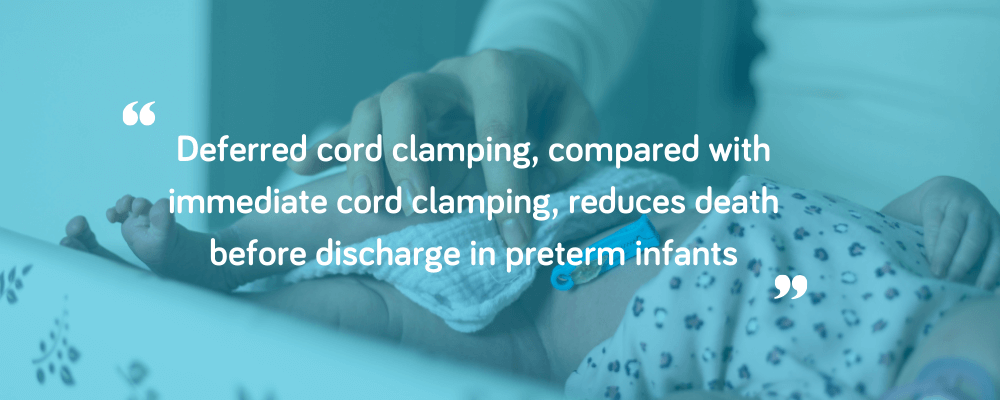Two Lancet publications1,2 from researchers at the Universities of Sydney and Nottingham, and the UK National Childbirth Trust have evaluated the effectiveness of different umbilical cord clamping and cord milking strategies in reducing neonatal mortality and morbidity. Global guidelines for preterm cord-clamping strategies vary considerably with recommendations varying from 30 seconds to at least 60 seconds. Some guidelines recommend cord clamping only when the lungs are aerated and others suggest cord milking as an alternative to deferred cord clamping. These studies aimed to compare the effectiveness of alternative strategies.
A: Comparing deferred cord clamping, umbilical cord milking, and immediate cord clamping
In the first publication, researchers conducted a systematic review and individual participant data meta-analysis examining 48 randomized controlled trials, encompassing a wealth of data from 6367 infants born before 37 weeks of gestation. The primary focus was on comparing deferred cord clamping, umbilical cord milking, and immediate cord clamping in preterm babies.
Methods and Outcomes:
The primary outcome assessed was death before hospital discharge. 48 randomised controlled trials were eligible with individual data on the outcomes in 6367 babies. Key Secondary outcomes included the need for blood transfusion, hypothermia (<37degC) on admission and intraventricular haemorrhage.
Key Findings:
Deferred Cord Clamping: The study found compelling evidence supporting the effectiveness of deferred cord clamping compared to immediate cord clamping. The odds ratio indicated a significant reduction in death before discharge (OR 0.68 [95% CI 0.51–0.91]) and a number needed to treat to prevent one death of 40. This result, backed by high-certainty evidence from 20 studies, suggests that delaying cord clamping may be a crucial factor in improving neonatal outcomes.
Umbilical Cord Milking: In contrast, no clear evidence of a difference in death before discharge was found when comparing umbilical cord milking with immediate cord clamping (OR 0.73 [0.44–1.20]) or deferred cord clamping (0.95 [0.59–1.53]). These findings, though inconclusive, shed light on the need for further research into the efficacy of umbilical cord milking.
Subgroup Differences: Interestingly, the study did not identify any subgroup differences for the primary outcome, including factors such as gestational age, type of delivery, multiple births, study year, and perinatal mortality. This suggests that the observed effects of cord clamping strategies were consistent across various subgroups.
The study found that in infants born before 32 weeks gestation, deferred cord clamping increased hypothermia on admission to the neonatal intensive care unit compared with immediate cord clamping. The study concludes that ‘particular care should be taken to keep infants warm when deferring cord clamping.’
Conclusion:
Based on the evidence, the study concludes that ‘deferred cord clamping reduces death before discharge in preterm infants, and this effect is consistent across different population groups.’ It also highlights that ‘effects of umbilical cord milking on mortality were inconclusive, but severe intraventricular haemorrhage is a potential safety risk.’
B. Impact of duration of deferred cord clamping:
A second publication2 from the same authors aimed to determine the optimal duration for deferred cord clamping, comparing various timings of clamping and cord milking. The researchers collected individual participant data from 47 trials involving 6,094 participants.
The interventions were categorized into immediate clamping, short deferral (15 to <45 seconds), medium deferral (45 to <120 seconds), long deferral (≥120 seconds), and intact cord milking. The primary outcome assessed was death before hospital discharge. The study found that, among all interventions, long deferral of cord clamping significantly reduced the odds of death before discharge compared to immediate clamping (0.31, 95% credibility interval, 0.11-0.80) with a number needed to treat to prevent one death of 18.
The results suggest that long deferral of cord clamping is associated with a reduced risk of death in preterm infants (and the researchers noted that the reduction in mortality increased with duration of deferral). However, the generalizability of this finding to infants requiring immediate resuscitation may depend on the availability of provisions for such care with the cord intact. The authors emphasize that these findings, based on rigorously cleaned and checked individual participant data, can contribute to future guidelines and clinical practice.
SurePulse:
These research findings are of particular interest to SurePulse who’s vision is to give clinicians and healthcare providers the tools to provide optimal newborn care. The SurePulse VS Cap comprises an optical sensor integrated into a thermo-protective single-use cap which has been designed to provide clinical teams with accurate, reliable, and timely information in the critical moments after birth. The latest ILCOR guidelines3 recommend the use of a cap to prevent hypothermia after birth. SurePulse VS’ wireless approach means that baby’s heart rate can be monitored straight after birth, supporting optimal care during stabilisation and, where necessary, resuscitation.
References
- Deferred cord clamping, cord milking, and immediate cord clamping at preterm birth: a systematic review and individual participant data meta-analysis, Seidler, Anna LeneSeidler, Anna Lene et al. The Lancet, Volume 402, Issue 10418, 2209 – 2222
- Short, medium, and long deferral of umbilical cord clamping compared with umbilical cord milking and immediate clamping at preterm birth: a systematic review and network meta-analysis with individual participant data, Seidler, Anna LeneSeidler, Anna Lene et al. The Lancet, Volume 402, Issue 10418, 2223 – 2234
- M. Berg et al., 2023 International Consensus on Cardiopulmonary Resuscitation and Emergency Cardiovascular Care Science With Treatment Recommendations: Summary From the Basic Life Support; Advanced Life Support; Pediatric Life Support; Neonatal Life Support; Education, Implementation, and Teams; and First Aid Task Forces, Resuscitation, https://doi.org/10.1016/j.resuscitation.2023.109992
